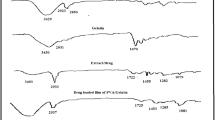Abstract
The wound is a biosynthetic environment in which numerous cellular processes are interlinked in the process of repair. Modern dressings are designed to facilitate wound healing rather than just to cover it. Hydrogel dressing can protect injured skin and keep it appropriately moist to speed the healing process by absorbing exudates while maintaining the products of tissue repair, including growth factor and lysosomes, in contact with the wound. The design and development of novel membrane of hydrogels prepared by esterification of polyvinyl alcohol with gelatin were attempted. Contact angle of goat blood was determined. The hydrogel was characterized by hemolysis test and water vapor transmission rate. Diffusion coefficient of salicylic acid (SA) and gatifloxacin, a fourth generation fluoroquinolone, through the membrane was determined. Both the drugs were used as model drug. Methyl tetrazolium dye assay of the membrane was done using L929 fibroblast cell line and mice splenocytes to establish the biocompatibility of the membrane. The equilibrium goat blood-in-air contact angles of measured ester films ranged from 56 to 60°. The hydrogel was found to be hemocompatible and moisture retentive indicating its possible use in moist wound care. The diffusion coefficient of SA and gatifloxacin through the membrane was found to be 1.49 × 10−5 and 3.97 × 10−6 cm2/s respectively. The membrane was found to be compatible with the L929 fibroblast cell line and mice splenocytes.






Similar content being viewed by others
References
P. GUPTA, K. VERMANI and S. GARG, Drug Discov. Today 7 (10) (2002) 569
W. E. HENNINK and C. F. NOSTRUM van, Adv. Drug Delivery Rev. 54 (2002) 13
K. KABIRI, H. OMIDIAN, S. A. HASHEMI and M. J. ZOHURIAAN-MEHR, Eur. Polym. J. 39 (2003) 1341
A. K. BAJPAI and A. GIRI, Carbohyd. Polym. 53(3) (2003) 271
F. ROSSO, A. BARBARISI, M. BARBARISI, O. PETILLO, S. MARGARUCCI and A. CALARCO, Mater. Sci. Eng. C23 (2003) 371
D. SARAYDIN, H. N. ÖZTOP, E. KARADAĞ, A. Y. ÖZTOP, Y. IŞIKVER and O. GÜVEN, Process Biochem. 37 (2002) 1351
G. ALVAREZ-LORENZO and A. CONCHEIRO, J. Control Release 80 (2002) 247
A. ACHARYA, H. MOHAN and S. SABHARVAL, Radiat. Phys. Chem. 65 (2002) 225
M. E. BYRNE, K. PARK and N. A. PEPPAS, Adv. Drug Deliver Rev. 54 (2002) 149
http://www.ysbl.york.ac.uk/projects/2/2.8.htm
F. HORII, S. HU, T. ITO, H. ODANI and R. KITAMARU, Polymer 33 (1992) 2299
N.A. PEPPAS and E.W. MERRILL J Biomed. Mater. Res. 11 (1997) 423
D. OAKENFULL and A. SCOTT Food Hydrocoll. 17 (2003) 207
A. BIGI, S. PANZAVOLTA and K. RUBINI, Biomaterials 25 (2004) 5675
H. BABIN and E. DICKINSON Food Hydrocoll. 15 (2001) 271
T. TANAKA, S. OHNISHI and K. YAMAURA, Polym. Int. 48 (1999) 811
K. PAL, A. K. BANTHIA and D. K. MAJUMDAR, J Biomater. Appl. 21(1) (2006) 75
R. J. YOUNG and P. A. LOVELL, Introduction to Polymers, 2nd edn, (Stanley Thornes Ltd: UK, 2004), p. 195
K. PAL and S. PAL, Materials and Manufacturing Processes 21 (2006) 325
ASTM E96-00e1: Standard test methods for water vapor transmission of materials
Y. HU, V. TOPOLKARAEV, A. HILTNER and E. BAER, J. Appl. Polym. Sci. 81 (2001) 1624
P. B. WACHEM VAN, A. H. HOGT, T. BEUGELING, J. FEYEN, A. BANTJIES, J. P. DETMERS and W. G. AKEN VAN, Biomaterials 8 (1987) 323
L. L. HENCH and E. C. ETHRIDGE, Biomaterials—An Interfacial Approach, Academic Press, p. 170
http://www.burnsurgery.org/Betaweb/Modules/moisthealing/part_2bc.htm
B. FALK, S. GARRAMONE and S. SHIVKUMAR, Mater. Lett. 58 (2004) 3261
Acknowledgements
The authors are thankful to Indian Institute of Technology, Kharagpur, India for funding the research. The first author is also grateful to his lab-technician and lab-mates (Mr. N. K. Mallick, Mr. A. H. Bhat, Mr. Arfat Anis, Mr. Dibakar Behera, Ms. H. Satapathy, Dr. (Mrs.) S. Mondal and Mr. P. Pawar) for their constant encouragement and support during the completion of the work. The authors are also thankful to Department of Biotechnology, Indian Institute of Technology, Kharagpur for allowing to use their laboratory for cytocompatibility tests and Ranbaxy laboratories limited, India for supplying gatifloxacin as a gift.
Author information
Authors and Affiliations
Corresponding author
Rights and permissions
About this article
Cite this article
Pal, K., Banthia, A.K. & Majumdar, D.K. Biomedical evaluation of polyvinyl alcohol–gelatin esterified hydrogel for wound dressing. J Mater Sci: Mater Med 18, 1889–1894 (2007). https://doi.org/10.1007/s10856-007-3061-2
Received:
Accepted:
Published:
Issue Date:
DOI: https://doi.org/10.1007/s10856-007-3061-2




